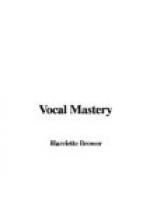Raisa assures us she works at technic every day. “Vocalizes, scales, broken thirds, long, slow tones in mezza di voce—that is beginning softly, swelling to loud, then diminuendo to soft, are part of the daily regime.” Farrar works on scales and single tones daily. Muzio says: “I sing all the scales, one octave each, once slow and once fast—all in one breath. Then I sing triplets on each tone, as many as I can in one breath. Another exercise is to take one tone softly, then go to the octave above; this tone is always sung softly, but there is a large crescendo between the two soft tones.” Kingston says: “As for technical material, I have never used a great quantity. I do scales and vocalizes each day. I also make daily use of about a dozen exercises by Rubini. Beyond these I make technical exercises out of the pieces.” De Luca sings scales in full power, then each tone alone, softly, then swelling to full strength and dying away. Bispham: “I give many vocalizes and exercises, which I invent to fit the need of each student. They are not written down, simply remembered. I also make exercises out of familiar tunes or themes from opera. Thus, while the student is studying technic, he is acquiring much beautiful material.”
Oscar Saenger: “We begin by uniting two tones smoothly and evenly, then three in the same way; afterwards four and five. Then the scale of one octave. Arpeggios are also most important. The trill is the most difficult of all vocal exercises. We begin with quarter notes, then eighths and sixteenths. The trill is taken on each tone of the voice, in major seconds.” Werrenrath: “I do a lot of gymnastics each day, to exercise the voice and limber up the anatomy. These act as a massage for the voice; they are in the nature of humming, mingled with grunts, calls, exclamations, shouts, and many kinds of sounds. They put the voice in condition, so there is no need for all these other exercises which most singers find so essential to their vocal well being.”
Duval asserts: “Long, sustained tones are too difficult for the young voice. One should sing medium fast scales at first.”
LENGTH OF TIME FOR DAILY PRACTICE
It may be helpful to know about how much time the artists devote to daily study, especially to technical practice. It is understood all great singers work on vocalizes and technical material daily.
Caruso is a constant worker. Two or three hours in the forenoon, and several more later in the day, whenever possible. Farrar devotes between one and two hours daily to vocalizes, scales and tone study, Lehmann counsels one hour daily on technic. Galli-Curci gives a half hour or so to vocalizes and scales every morning. Martinelli practices exercises and vocalizes one hour each morning; then another hour on repertoire. In the afternoon an hour more—three hours daily. Easton says: “It seems to me




